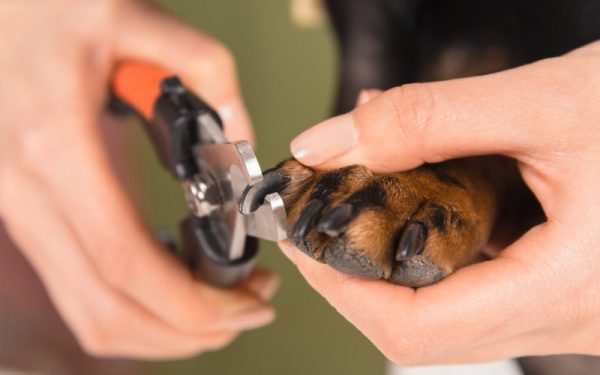Dogs have a powerful sense of smell that is estimated to be 10,000 to 100,000 times better than that of a human. This incredible skill makes them excellent hunting companions and detection animals. Some dogs have about 20 times the number of smell receptors as humans do.
A dog’s nose contains up to 300 million olfactory receptors (humans have about 6 million), and the part of their brain devoted to smell is about 40 times greater than ours. So, just how far can dogs smell? In perfect conditions, dogs are reported to smell things as far as 20 km (12.4 miles) away.

How Far Can a Dog Smell?

Brachycephalic or short-faced dogs might have an impaired sense of smell due to their compromised airways. Dog breeds that are bred to track and hunt, like Bloodhounds or Beagles, also have a better-developed sense of smell than most other breeds.
Approximately 40% of a dog’s brain is devoted to smell. Humans have about 6 million olfactory receptors. Most dogs have about 100 million. Scent hounds have up to 300 million.
- Bloodhounds — These dogs have a long history of scent tracking for law enforcement. Bloodhound’s sense of smell is considered to be so accurate that it is even accepted in a court of law.
- Beagle — Beagles are frequently used to sniff out narcotics for U.S. Customs and Border Patrol agents.
- German Shepherd — This is the leading dog breed for use in the police force and the military. These dogs use their incredible sense of smell for narcotics detection and search and rescue.
- Dachshund — The small but mighty Dachshund excels at detecting smells below ground. This breed was originally bred to hunt badgers and underground vermin.
- Harrier — Harriers earned their name due to their excellent ability to track hares. They are dedicated hunters that can sniff out prey from miles away.
- Basset Hounds — Second only to Bloodhounds for their sniffing abilities, these dogs are occasionally used for search-and-rescue missions.
- Coonhounds — Coonhounds of many varieties are used as hunting dogs because they can track scents for miles. Their sense of smell is so refined that they can detect faint scents left behind for days.
- Labrador Retrievers — Labs excel at scent detection. They are used for search-and-rescue missionss, explosives detection, and medical assistance.
- Golden Retriever — This breed is used for search and rescue, and many are trained as service dogs to sniff out potential allergens for their owners.
- Belgian Malinois — The Malinois is a popular military service dog because their keen sense of smell enables them to detect explosives. This breed is the only dog breed used by the Navy SEALS. Along with their excellent sense of smell, they have an amazing work ethic, speed and endurance that lends them to emergency takedowns of suspects or enemy combatants.

Which Factors Influence a Dog’s Sense of Smell?
Weather conditions have a direct impact on a dog’s smell range. On a hot day, smells travel farther. Wind can carry a smell toward or away from a dog’s nose. In cold weather, smells settle close to the ground. Other factors also affect a dog’s sense of smell:
- Health status —A dog with a dental infection or another disease affecting the nasal passages and sinuses may have an impaired sense of smell.
- Age — Like humans, dogs’ hearing, sight, and sense of smell decrease as they get older.

Dogs Use Their Sense of Smell in Everyday Life

Dogs use their sense of smell to explore the world around them and interact with other dogs and people. They also use it to communicate. Your dog can recognize individual unique scents and when they meet another dog, they gather information about them by sniffing them thoroughly. They leave scent marks wherever they go through urine, feces, anal gland excretions, and scent glands on their paws.
If your dog was bred for hunting or tracking, their ancestors would use their keen sense of smell to find prey. Your dog may flex their natural instincts when out walking; don’t be surprised if your scent hound ignores your call to focus on a particularly intriguing scent.

Facts About a Dog’s Sense of Smell
Dogs’ noses are incredible! Here are a few interesting facts about a dog’s sense of smell:
- When dogs breathe out air is forced into the nose because of the way the air leaves through the sides, creating a continuous circulation of air that helps their sense of smell. When they breathe in the air is split into two routes, one for breathing and the other for smelling.
- A dog can smell chemosignals produced by people and other dogs in different emotional states, allowing them to identify when someone is stressed or happy.
- Scent-tracking dogs are trained to focus exclusively on one smell and ignore thousands of other smells.
- Search dogs often operate on air scents that are carried by the wind.
- A dog’s wet nose enables them to capture scent particles more effectively.
- Dog nose prints are like human fingerprints; no two dogs have the same nose print.


Summary
Dogs have a powerful sense of smell. They can smell things that humans can’t, which makes them excellent at tracking all sorts of things, from people and invisible allergens to drugs and bombs. The smell is one of your dog’s best senses. Even if they aren’t trained at scent detection, your dog uses their nose to navigate the world.
Related Reads:
- 15 Interesting Bloodhound Facts You’ll Love to Discover
- Is a Bloodhound a Good Guard Dog? Facts, History, & Alternative Options
Featured Image Credit: Damix, Shutterstock



















